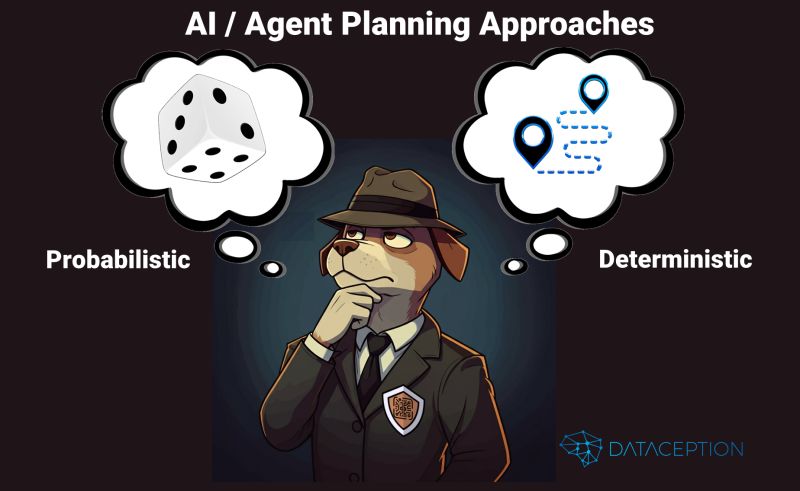This weekend, I had a fascinating discussion that reinforced a critical but often overlooked part of Agentic AI design—the strategic choice between deterministic and probabilistic planning.
When building enterprise-grade agent systems, the question isn’t just how agents make decisions, but how they plan—how they break down tasks, execute workflows, and maintain reliability.
🐕 Two Approaches to Agent Planning
🧠 Probabilistic Planning (Chasing the Squirrels)
🔹 Uses LLMs to dynamically create execution plans
🔹 Flexible, context-aware, and adaptive
🔹 BUT: Plans can change unpredictably, leading to bias, inconsistency, and lack of repeatability
🔹 Works well in creative, exploratory, or loosely defined use cases
🎯 Deterministic Planning (Following the Path)
🔹 Uses predefined rules and structured workflows (Parcha called this “Agents on Rails”—a term I like!)
🔹 Provides reliability, predictability, and repeatability
🔹 BUT: Can struggle with novel situations and dynamic flexibility
🔹 Ideal for regulated, high-assurance workflows like compliance, risk, and finance
Parcha did a great write-up on why purely probabilistic planning failed for them (link in comments), but there are plenty of valid use cases where it works. The real answer? It depends on the architecture.
🛠 The Architecture is the Solution
It’s NOT about choosing one over the other. It’s about knowing when and how to use them together.
The best enterprise-grade agent systems don’t eliminate LLMs—they integrate them as "glue" between deterministic components.
That’s exactly how we use AI/LLM-generated Data Object Graphs (DOGs)—as a dynamic execution layer that balances structure with flexibility.
🔑 Three Key Considerations for AI Agent Planning
1️⃣ Decomposition Over Delegation
👉 Instead of handing over entire workflows to a large LLM, break complex tasks into structured, modular components. This keeps things controllable while still leveraging AI for dynamic execution.
2️⃣ Match the Tool to the Risk Tolerance
👉 Use deterministic methods for high-assurance tasks (compliance, risk assessment, mission-critical operations).
👉 Use probabilistic methods where contextual adaptability is more valuable than rigid consistency (creative workflows, conversational AI).
3️⃣ Consider the Benchmark
👉 We aren’t comparing AI agents to perfect deterministic systems—we’re comparing them to human processes, which are inherently probabilistic and inconsistent.
👉 Sometimes, AI only needs to be "good enough"—but knowing when "good enough" isn't enough can prevent costly failures down the road.
🤝 Blending the Two: A Real-World Example
A colleague shared a hybrid approach they implemented:
💡 Scenario: An AI-powered chatbot for complex product recommendations
✅ Deterministic: The overall user journey follows a structured, well-defined flow
✅ Probabilistic: The questions adapt based on the user’s industry and role, dynamically adjusting responses at each step
This blend creates an AI system that is structured yet flexible, adaptable yet reliable—a perfect example of the "bounded creativity" approach.
🚀 The Future of Enterprise Agentic AI
The real key to scaling AI Agents isn’t just better models—it’s better architecture.
- Deterministic components provide structure and guardrails
- Probabilistic components provide adaptability and contextual understanding
- Data Object Graphs (DOGs) act as the intelligent execution layer that ties them together
We wrote about Agentic Query Plans in a previous blog post, which provides another perspective on this hybrid approach.

Would love to hear your thoughts! Please reach out to us to learn about how we can help you with deterministic and probabilistic approaches coexisting in AI-driven workflows.
With Dataception's DOGs, AI is just a walk in the park. 🐕🚀

